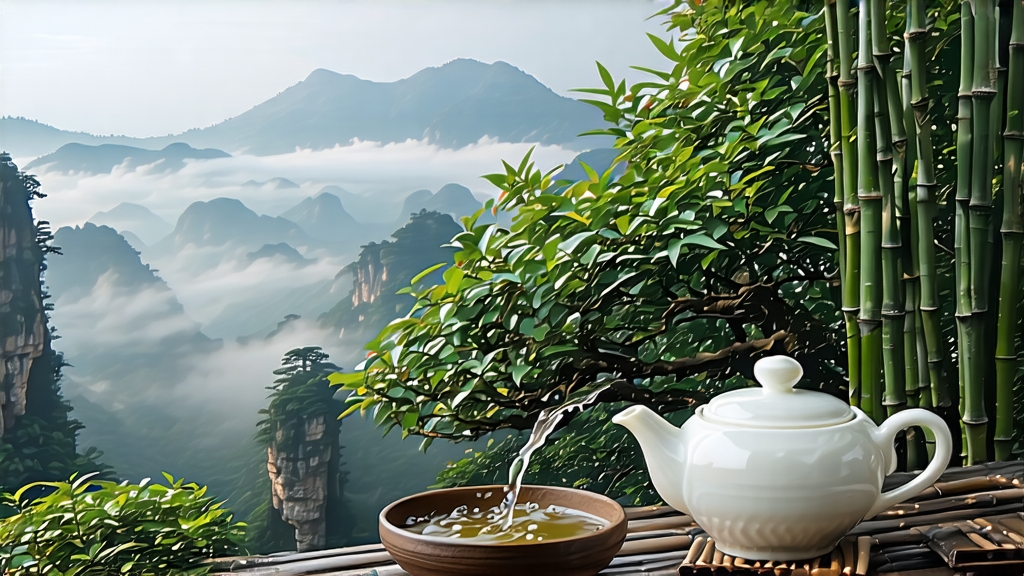
High in the UNESCO-listed Wuyi Mountains of northern Fujian, narrow plank walkways are nailed into sheer cliffs. Below them the Jiuqu Xi River bends like a calligrapher’s brushstroke through purple sandstone gorges. It is here, in these mist-pregnant crevices, that Shui Xian—literally “Water Sprite” or “Narcissus”—has been coaxing its haunting rock-rhyme from volcanic soil for more than three centuries. To international drinkers the name may sound romantic yet vague; to Chinese tea elders it is a benchmark against which all other dark, strip-style oolongs are measured. This essay invites you to travel from Song-dynasty monastic legends to the charcoal pits of 2024, learning how a single cultivar can embody geology, craftsmanship, and the slow art of patience in one cup.
-
Historical echoes
The first written record of Shui Xian appears in the 1717 county gazette of Chong’an, stating that “the monks of Tianxin Temple grafted tea from the Hu Xian Yan cliff onto garden stock; the infusion smells of winter narcissus.” Local lore adds colour: a wandering scholar, parched and lost, dreamed of a fragrant flower that led him to a hidden spring; upon waking he found a tea tree whose leaves smelled exactly like the bloom. He named the tree Shui Xian and propagated it by air-layering. Whether myth or marketing, the story underlines two enduring qualities—floral perfume and water worship—that still define the tea. By the late 19th century Shui Xian had eclipsed the earlier Song-luo compressed tribute teas and was freighted down the Mei River to the port of Fuzhou, where European buyers christened it “Bohea Narcissus” and blended it into scented black teas. The original Wuyi mother trees, now protected, still stand outside the Dragon Cave on Hu Xian Yan, their trunks as thick as a man’s thigh, gnarled like ancient bonsai. -
Terroir: the mineral womb
Wuyi’s Danxia landform—oxidized red sandstone and conglomerate—crumbles into gravelly soil that drains instantly yet retains heat. Day-night temperature swings can exceed 15 °C; fog refracts sunlight into a soft, bluish glow that lengthens the growing season. These stresses force the plant to synthesize more aromatic volatiles and soluble minerals, especially potassium and magnesium, which translate into the celebrated “yanyun” or rock-essence—a tactile dryness that echoes the taste of wet stone after rain. Within the 60 km² core scenic reserve only tea grown above 300 m and within sight of the river’s nine bends may legally be sold as “Zheng Yan” (True Cliff). Shui Xian, being a semi-tall shrub rather than a dwarf bush, thrusts its roots into fissures where other cultivars cannot survive, mining nutrients at depths of two metres or more. -
Cultivar biology
Shui Xian is a sexually propagated landrace, not a cloned modern hybrid. Its genome shows markers of both Wuyi Qizhong (original “strange cultivars”) and Minbei wild tea. Leaves are broad, elliptical, and slightly corrugated; the serrations turn reddish in autumn, giving the mountain a coppery shimmer. Compared with the more famous Da Hong Pao, Shui Xian contains higher levels of linalool and geraniol, accounting for its pronounced orchid note, yet lower catechins, yielding a softer, less astringent body. Harvest window is narrow: two leaves and a bud must be plucked when the third leaf is still half-folded, usually between 30 April and 5 May, before the mountain rains swell the tissues and dilute flavour. -
Craft: the eight-step charcoal tango
After picking, leaves are withered on bamboo screens set on cliff-side racks where updrafts remove 65 % moisture in four hours. They are then shaken in rattan drums every 30 minutes through the night to bruise edges and initiate oxidation. At 60 % redness—judged by eye—the leaves are flash-fried at 220 °C for 90 seconds to kill green enzymes, followed by rolling into long, blackish-green stripes. What distinguishes Shui Xian is its baking. Traditionally the tea is loaded into 40 kg hemp sacks and placed inside a ring of glowing charcoal made from local hardwoods (mostly